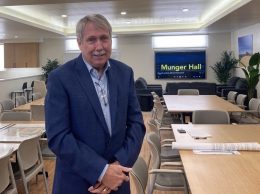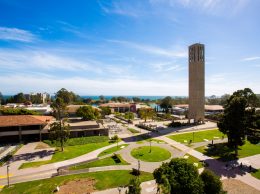Op/ed: Report on Isla Vista gets an ‘incomplete’
IN THIS ARTICLE
- Op/Eds Topic
- Guest commentary Author
By Guest commentary Friday, November 28th, 2014
By Carmen Lodise
I thought Henry Dubroff’s column on Isla Vista [published in the Nov. 21-27 edition of the Business Times] was an excellent summary of the UC Santa Barbara Trustee’s report.
However, I found the report itself to be a thoughtful, if overly intellectual, analysis of present-day Isla Vista. I certainly agree with the independent committee that Isla Vista suffers from “inadequate representation, insufficient public services and a lack of infrastructure . . .” But that’s been the reality for 50 years, and the question remains: “What do we do about it?
I found three excellent recommendations scattered among a dozen ideas of far less importance:
1. The need to move toward more self-government in “a legislated community services/municipal improvement district.” As I understand it, Assemblymember Das Williams and State Senator Hanna-Beth Jackson are working on such legislation. I’ve always held that it’s only when residents have responsibility will they pay attention to the rules.
2. The need for a community center in Isla Vista. Structures in the center of town are now available following the dissolution of the redevelopment agency. What is needed are funding and a local governance mechanism.
3. The need for a functioning “Isla Vista Stakeholder Work Group” to get everyone talking.
But what’s missing from the Trustees’ report is critical:
1. A business plan that discloses costs and timing in relation to its recommendations.
2. An examination of how the university has contributed to the problems facing Isla Vista. Isn’t there a correlation between increased problems and expanding enrollment? Add in the 2,000 or 3,000 Santa Barbara City College students who now live in the community, and it’s a pressure cooker out there. The Trow Report to the UC Regents following the 1970 civil disturbances recommended UCSB enrollment be capped at 15,000 but now it’s over 20,000 and headed to 25,000.
And parking? Couldn’t the university limit car ownership to seniors as many other universities do? That would alleviate most of the town’s parking problems.
Perhaps it’s beyond the scope of this committee, but certainly Santa Barbara County, especially the law enforcement apparatus, has contributed to the current situation. Increasingly suppressive laws about music and drinking have not alleviated the situation, which erupted in the Deltopia disturbances last spring. And all those new three and four-story apartment buildings with inadequate parking — hardly helpful.
Is Isla Vista’s party culture any different than others college students’ across the nation? I don’t think so. It’s the density and the continued assertion by outside authorities in attempts to suppress the rambunctious behavior of youth that make the difference.
Certainly, the governance by these overseers has been a failure, which has brought us to yet another crisis. It’s time to try self-governance and resident responsibility. After all, the majority of the town is inhabited by the smartest young people the state turns out — now and forever. They couldn’t do any worse than the current cabal.
I have two questions to ask the overseers:
1. If the university hadn’t blocked Isla Vista becoming a city in the ’70s and ’80s, would it be such a problem today?
2. How many of these problems would go away if UCSB cut enrollment by 25 percent?
Finally, except for recommending self-governance, the trustees’ observations differ little from those in the 1970 Trow Report. Here are some excerpts:
“If there is one thread running through all of our deliberations and recommendations, it is that the university can no longer ignore, if it ever could, the conditions under which the bulk of its students live and spend the greater part of their time while at the university. “
“What goes on in Isla Vista is as central to the university’s life and functions as what goes on in its laboratories and lecture rooms.”
“Isla Vista is deeply scarred by the events of the past. Without indigenous institutions, the community can continue to be torn apart. But if increasing numbers of Isla Vista residents can feel that they are able to improve their own environment, Isla Vista can become a distinguished university community. Because of the unique local environment of Isla Vista, the ingredients are present for a promising experiment in community development.”
“…[T]he local [UCSB] administration’s attitude that the improvement of Isla Vista’s environment was of secondary importance in the long-range development of the campus…reflects a failure to consider the campus and Isla Vista as an integrated university community…”
“In a sense, UCSB is the most powerful ‘citizen’ in Isla Vista, yet in our opinion, it has refused to assume its proportionate civic responsibility.”
• Lodise is the author of “Isla Vista: A Citizen’s History,” published in 2008.









